In an effort to bring you some new voices on Ottsworld, here is a guest post from Kit Parks. I met Kit at a blog conference. I learned that she is a podcaster and an avid long distance hiker; we immediately hit it off! We shared stories on different long distance walks and bonded! She recently retired and bought a campervan! I invited her to write a guest post about campervan road trip tips and lessons learned! All opinions and experiences expressed here are hers. –Sherry
With my summer European adventures cancelled due to the pandemic, I was chomping to figure out how to safely travel without risking my health or for me to be a Typhoid Mary due to Covid. What better way than a campervan to explore this great country’s landscapes that I am blessed to call home?
This situation calls for a campervan road trip, I am bringing my home with me, which seems to be a heck of a lot safer than changing hotels every few days. With a campervan, I really only have to be around people when I get groceries, and sometimes when I get gas.
Campervan travel is the perfect means of travel during a pandemic!
Table of Contents
How I Bought My Campervan
Inexplicably late February, as Covid was rearing its ugly head in Italy (where I was scheduled to visit early March), I looked at campervans on eBay and spontaneously bid on a converted 2011 Sprinter cargo van that had everything I wanted in a camper, except that I didn’t plan on buying one for another five years or so, once I finished the bulk of my international adventure travel goals.
I woke up the next morning to discover that my bid was accepted and now I was the proud owner of a converted cargo van in Vermont. Whoa! New York City was starting to become a Covid hotspot, so I booked an immediate flight to Vermont so I could hopefully drive my new-to-me campervan back to North Carolina before the spread was worse, and thus avoid being a carrier.
Fast forward five months, where we now have a handle on how to best protect ourselves and others from Covid, so it was time to take my camper, which I named ‘Sophie’, on our maiden road trip.
Since I luckily sold my business in mid-June and became officially retired, I could set out and decide as I went, where to go and how long to stay. Having my own home on wheels made doing so especially convenient plus gave me the confidence to travel without a plan, knowing I would always have a place to rest my head, regardless of the weather.
I am now in my fifth week of traveling in Sophie, and I’ve learned a few things I want to share with you.
3 Things to Decide When Traveling by Campervan
There are three main decisions you’ll need to make when traveling by campervan (and much of these tips can be adapted to
• What features do you personally need in your campervan
• What types of places you want to explore?
• Where do you want to park your campervan and what types of places you want to stay?
1. Determine What Campervan Features YOU Need
Taking your home on the road can be as simple as packing your gear in your car or on your bike, and hitting the road. Or you can spend over a quarter million dollars to rig out the fancy bus-like RV’s with custom leather seats, wide screen TV, a king-sized bed, and a washer and dryer – and I’m not kiddin, I’ve been in one of those!
The key features are the same for both methods, but the difference is your comfort and cost. I’ve provided some budget and more ‘comfortable’ options for your main campervan features. Like in everything, you are always trading dollars for comfort and convenience.
Basic Questions for Choosing or Buying a Campervan
How will you sleep? Your Campervan Bed
You could bring a blow up mattress and toss it in the back of a cargo van, or bring a tent and sleep in there if you are simply taking your car.
In Sophie, I have a full-sized foam mattress elevated on a deck that I access by stepping on a seat topping my 12v Refrigerator chest cooler. Larger RVs will have bump outs that allow for regular mattresses.
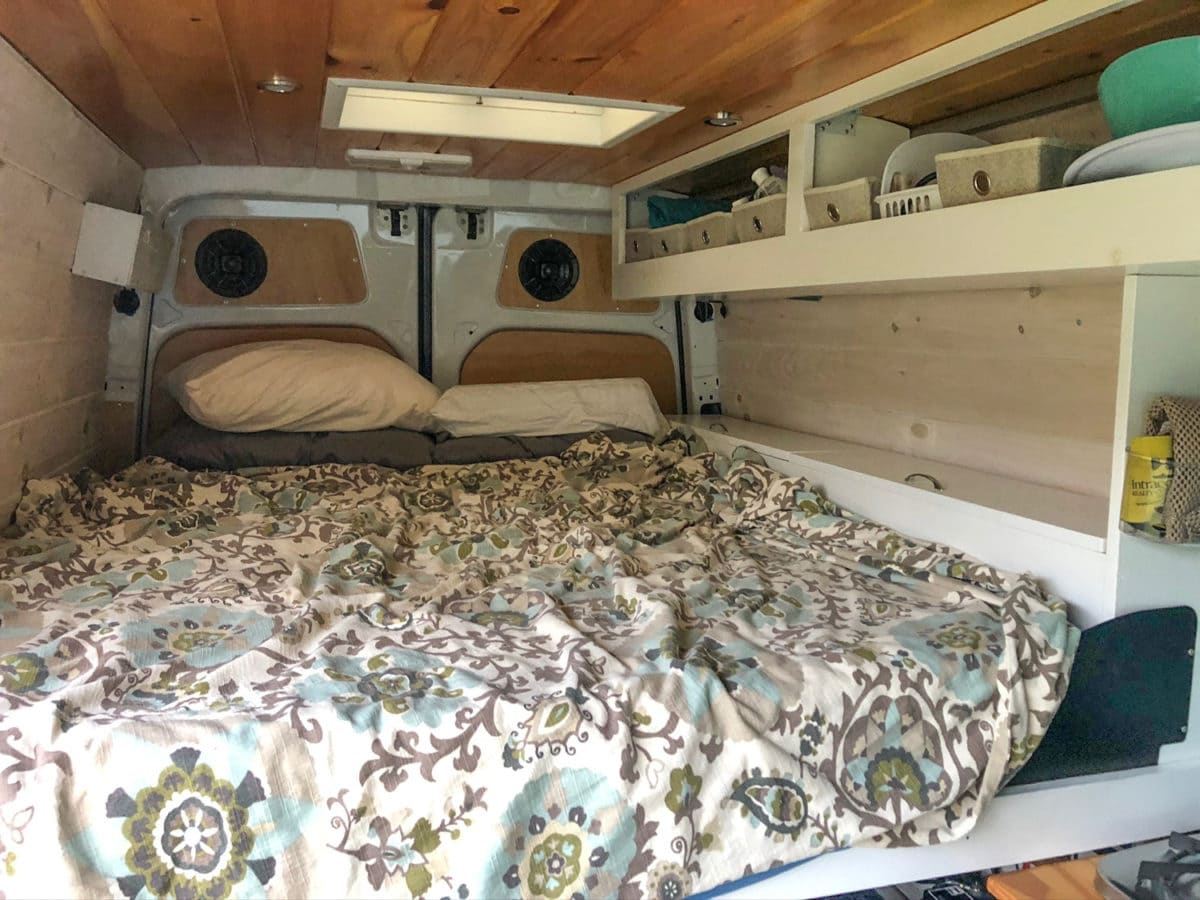
How will you keep your food refrigerated? Your Campervan Cooler
You could bring a chest cooler and keep filling it with ice, which can be expensive as well as a pain. You could buy a plug in (110v and/or 12 volt) chest cooler that you stick in to your cigarette lighter when traveling, and plug in to an outlet at camp (but you’ll need to pay for a campsite with power).
Sophie has a 12 volt chest refrigerator that I keep set at 37 degrees which runs off of two solar panels on her roof. Many RV’s and campers come with a generator and/or solar panels.
How will you get fresh water? Your Camper Faucet
At its most basic, you could buy a water jug that you fill with fresh water and let gravity act as your pump, and then use a plastic dishpan as your sink.
Sophie has a small kitchen cabinet with a sink and a propane burner. Under the sink is a small pump, which pumps water from a 6 gallon jug, and the sink drains into a separate grey water jug that I dump before leaving a campsite.
I also have a backup 6 gallon jug in case I know I’ll be away from a water source for a few days. I have learned to keep at least a couple of gallons in there so when my first jugs runs dry, I know I have enough to get through another day. The larger camper vans will have a more elaborate system than mine but they basically do the same thing.
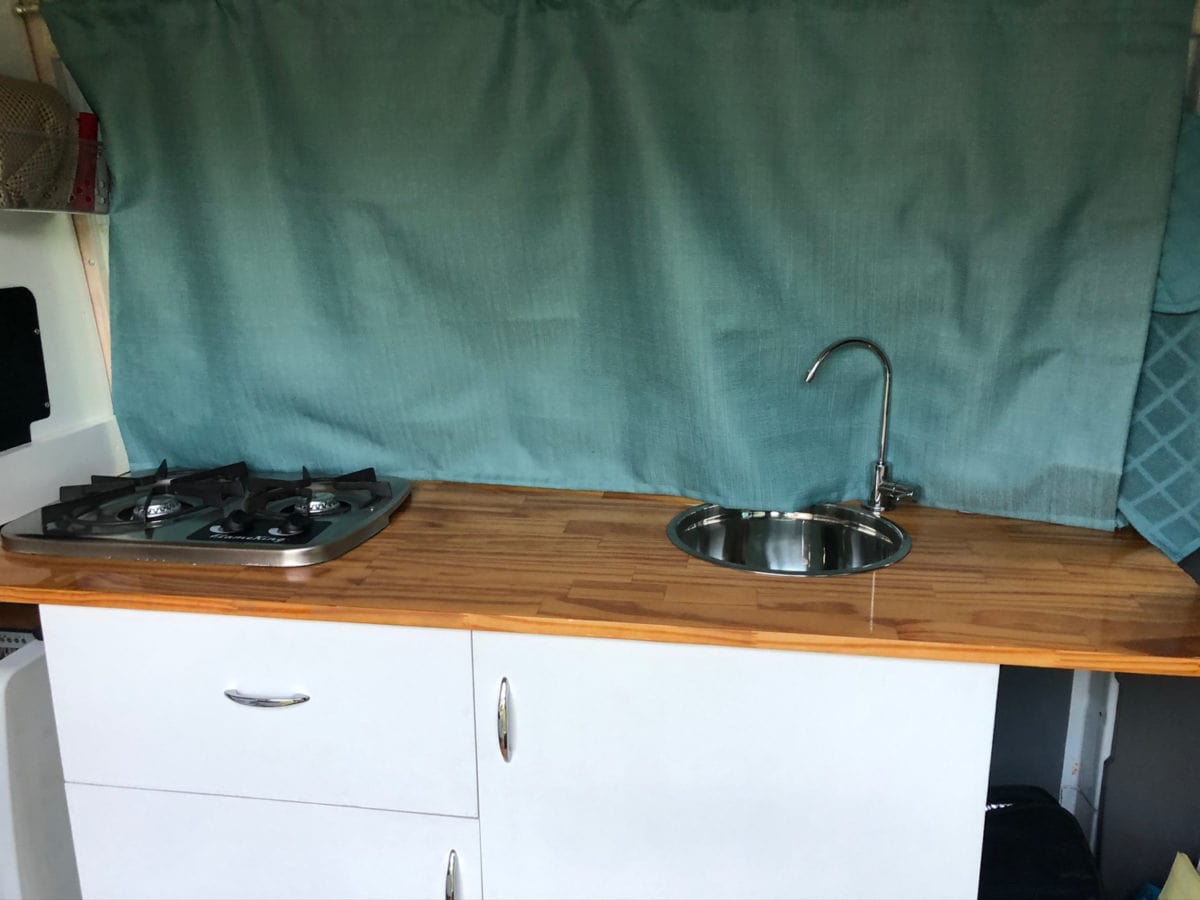
How will you cook your food? Your Camper Stove
You can cook over a campfire, (when fires are allowed), or bring a camp stove, which is an inexpensive option. You could also bring a portable propane cooktop that you can set up on a picnic table.
Sophie has a two burner cooktop built onto her kitchen cabinet countertop. Larger RVs usually have bigger propane cooktops.
How will you see at night? How will you charge your electronics? Your Campervan Power
A headlamp and battery operated lantern fit the bill economically for car campers.
Sophie has two solar panels on her roof which, even on cloudy days, generate enough power to keep the 12 volt battery charged up enough to power my fridge, which is most critical to me. I also have two overhead reading lights and some overhead mood lights on dimmer, plus three USB charge ports that all run off my solar powered battery.
As a backup power source, I have a SINE inverter which, as a backup, can also charge the battery, plus powers a 110 v electrical outlet that I can use for low wattage appliances and electronics.
For convenience sake, I usually reserve a campsite that has a water pump and an electrical outlet. Campground sites with power have a dock station with a 30 amp plug that most modest sized RVs use – the larger bus-like RVs will need a 50 amp plug, which you usually pay more for. They also have a 110 volt outlet that I use. I bring an outdoor extension cord so that I don’t need to use my inverter outlet, as that pulls off my van battery and I don’t want to drain it unnecessarily (I recommend bringing a 50’ length extension cord).
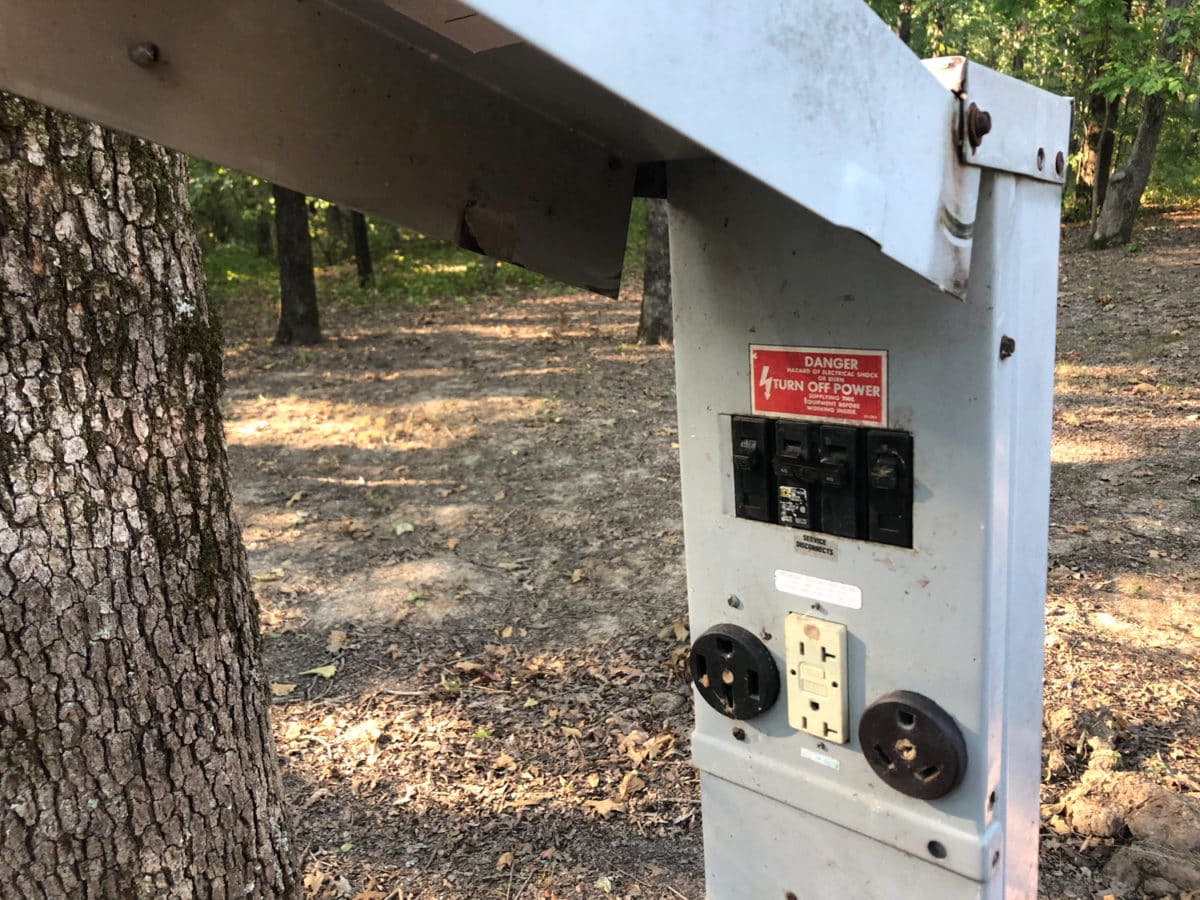
How will you handle temperature control? Your Camper AC and Heater
Car campers do without, unless they run their car, of course.
Sophie has no AC, so I bought a small fan and can plug it in to keep me cooler at night. She does have a heater that runs off my diesel gas and has a switch that will turn it off if my gas levels drop too low so I don’t get stranded. Most RVs and camper vans have both an AC and a heater.
How will you get clean? Your Campervan Shower
Car campers either bird bath it or use campsite bathhouses.
I have to do the same with Sophie as I have no built-in shower. Larger campervans and RVs have a shower. Like your sink waste water, with RVs, you pump out your grey water when full or before leaving your campground. They all have a station for you to do so.
Where will you sit and eat? Your Camper Living Room and Dining Room
Car campers should pack a folding chair and ideally a small table.
I do the same. Most campsites come with a picnic table, but it might be in the full sun on a blistering hot day. With portable chairs and table, you get to choose where to relax.
The larger the camper van or RV, the more elaborate the living room. Nonetheless, I think regardless of the size of your camper van or RV, you should bring your own ‘outside use’ chairs and a table.
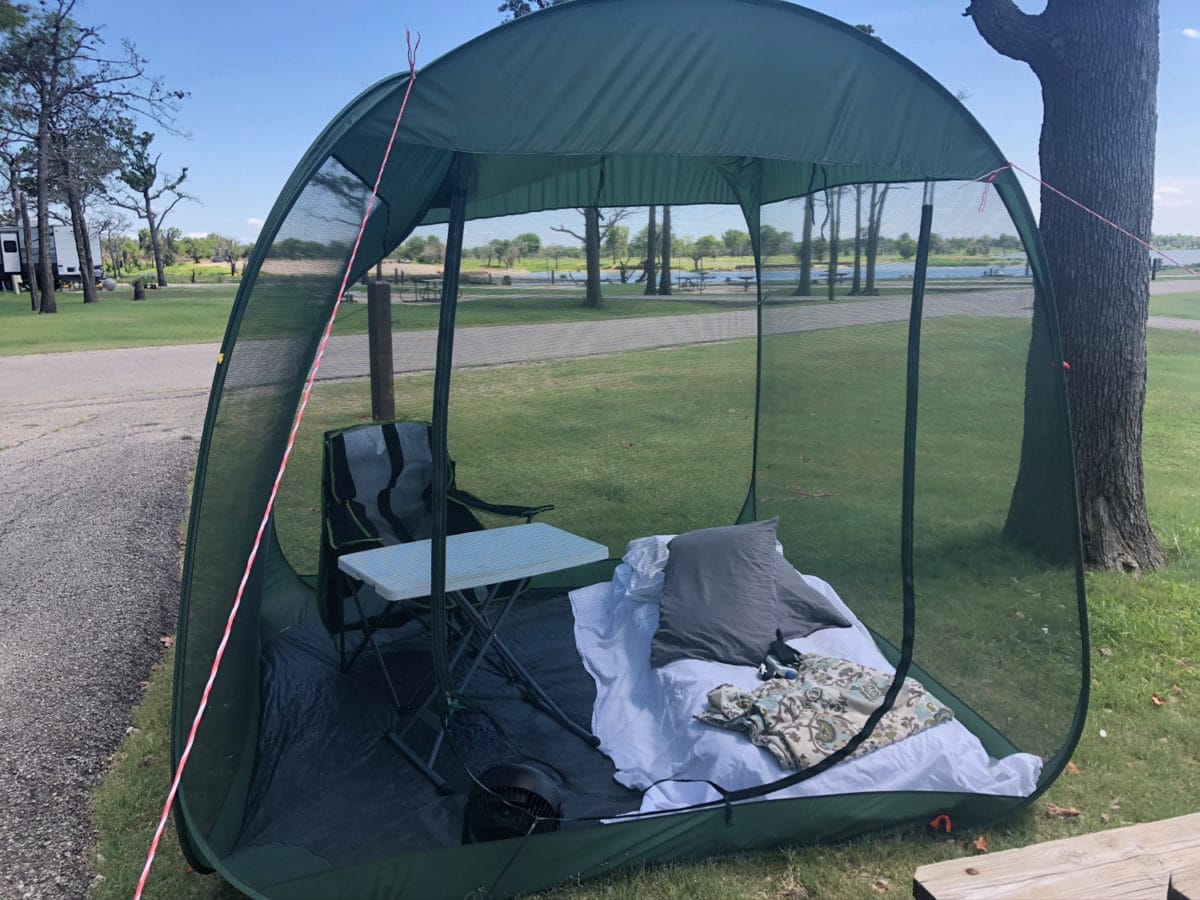
Likewise, I would strongly recommend if you have the space, to bring a portable screen room. When the weather is nice, I sleep in mine and love it! No bugs and perfect star gazing! My 8’ x 8’ screened porch fits my table and chair, plus a twin sized blow up mattress easily, yet compresses to a thin 3’ circle when packed up. Car campers can fit this in their car, too!
Where will you store your clothes and supplies? Your Campervan Closet and Pantry
First of all, bring less than HALF of what you think you’ll need. It’s the same as at home: you wear the same things over and over again. Regarding food, try to limit your menu so you don’t have to bring so many different food items.
Since I’m on my maiden Sophie journey, I knew I packed her too full, but the problem was, I wasn’t sure what I should leave behind. In this supplemental list, I outline what I’ve actually USED. The less stuff you actually “NEED”, the smaller camper van you can get away with. Even in a larger unit, the less stuff you haul around, the better your gas mileage.
My ‘closet’ in Sophie is a cheap plastic three drawer chest. One drawer has my jackets and other cold/rainy clothes like my woolies (long johns) and extra shoes. One drawer has my city clothes. One drawer has my regular hiking, biking and outdoor clothes, undies, socks, etc.
My ‘pantry’ in Sophie is a non-plugged in 12v/110v chest cooler I brought for backup. I store medicine, nuts, bread, crackers and everyday items that don’t need refrigeration, but would appreciate not being 120 degrees sitting in the van when parked. There are some built in compartments where I store (still unused) other pantry items like tuna cans, pasta sauce, etc. RVs and campers will have some sort of storage system for you. Again, the larger the camper, the more elaborate the storage system. Car campers could get by with two large tubs: “pantry” and “closet”.
Where will you store your bikes, kayaks and other gear? Your Campervan Garage.
It’s more fun to explore the outdoors when you have the right toys! I brought a hybrid bike, but I’m sorry I didn’t bring a mountain bike. I take of the front wheel and it stores nicely under half of my bed. Above the bike, I built a shelf which store my pop up screen porch.
On the other half of the van bed by the bike is another shelf which extends to the frig. On this shelf, I store hardware for any repairs, my fold up chair and yoga gear. Below the shelf are two tubs: one holds my backpacking gear and the other my bike and kayaking gear. Behind the two tubs is an inflatable kayak. I mounted a paddle next to the shelf.
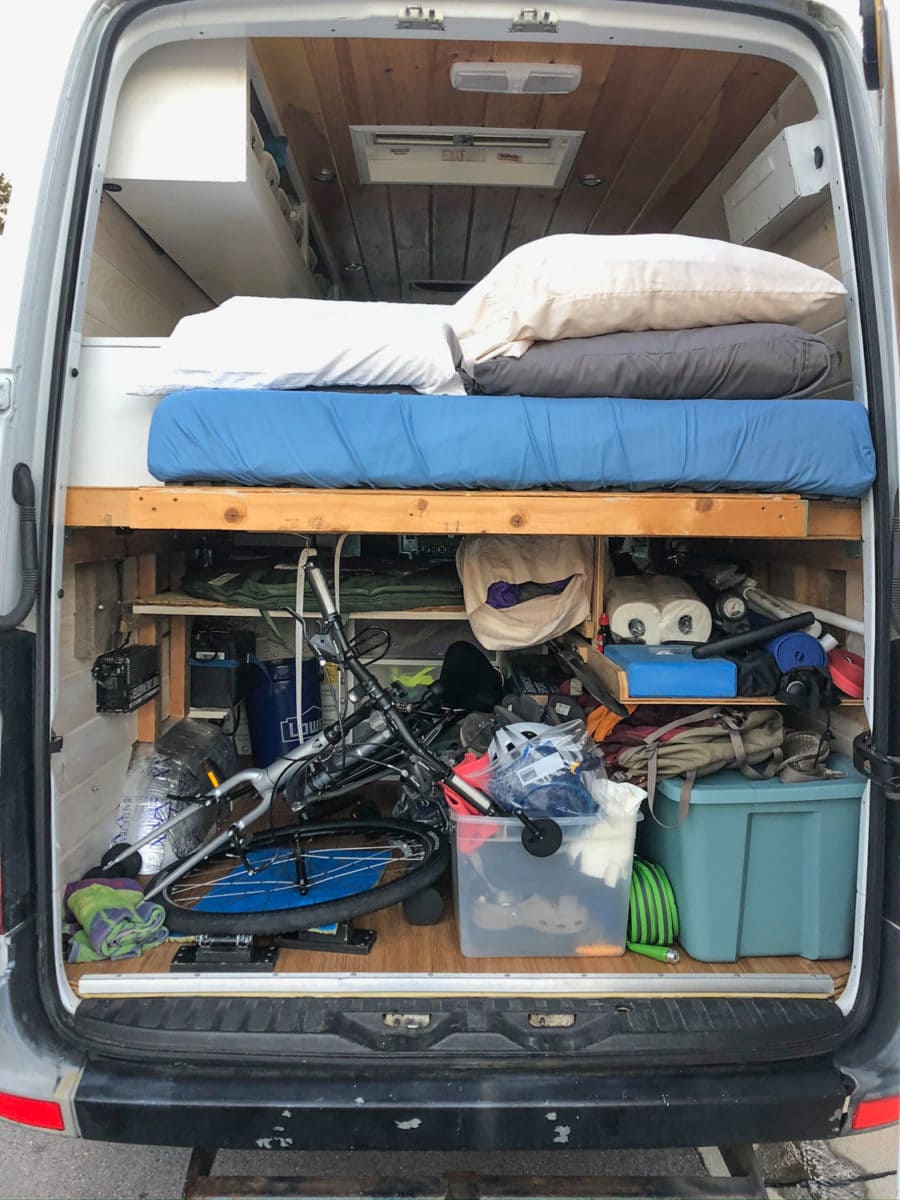
Behind the bike, but just under my kitchen counter neatly stores my fold up table and a 5 gallon bucket that I use as my toilet when one isn’t available. Most camper vans, if you pay enough, come with a toilet that you can pump the waste, along with your collected grey water into a dump station as you leave your campground.
Determining beforehand what kind of activities you want to do, will help you to determine what size camper van you will need. Note that you can also haul your bike on an exterior bike rack and a kayak can go on the roof if you need the space.
If You Prefer to Car Camp Rather Than Use a Campervan
If you drive an SUV or Jeep, another way to ‘glamp’ up
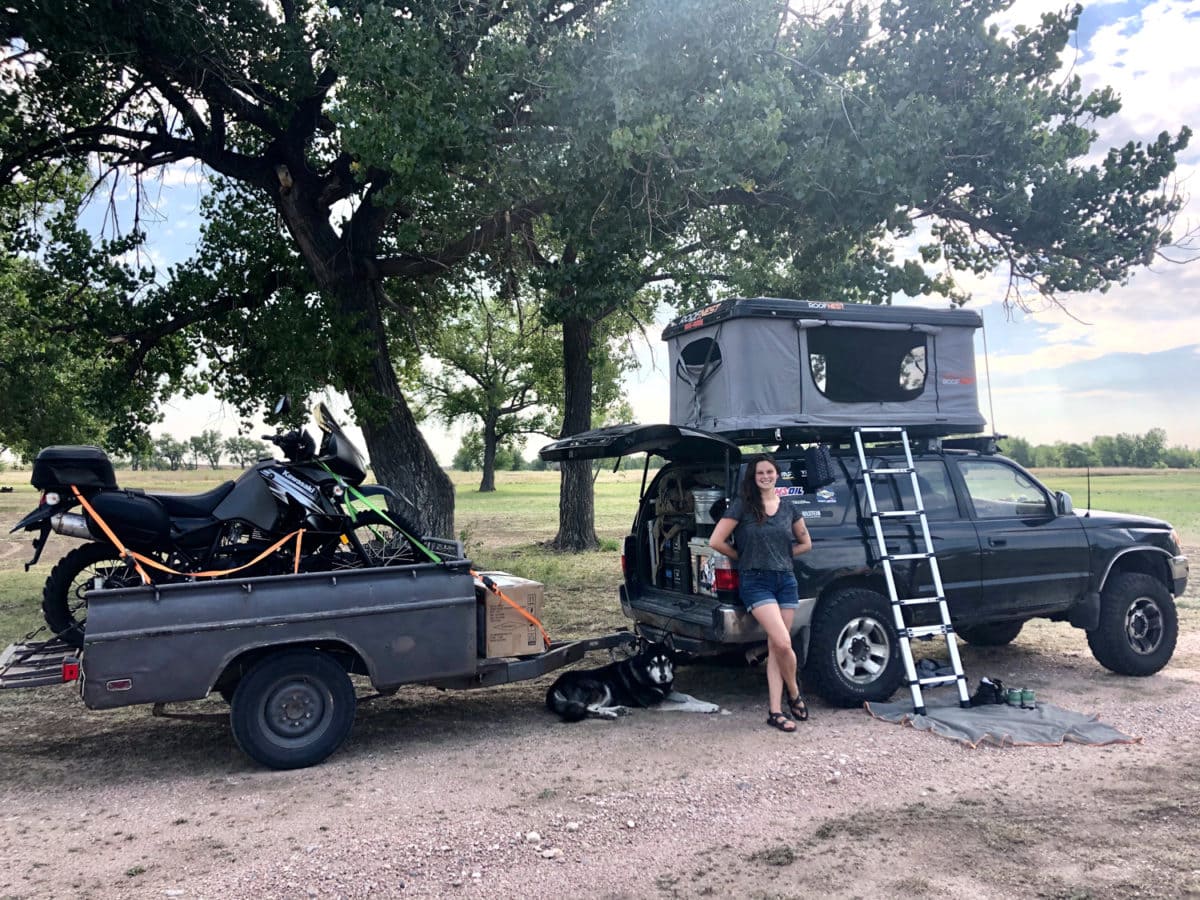
If you go this way, be sure to read my Solo Car Camping Tips article!
Now that you have decided what YOU need as features for a camper van, you can shop around to get the rig most appropriate for your particular needs and budget
PIN IT FOR LATER!
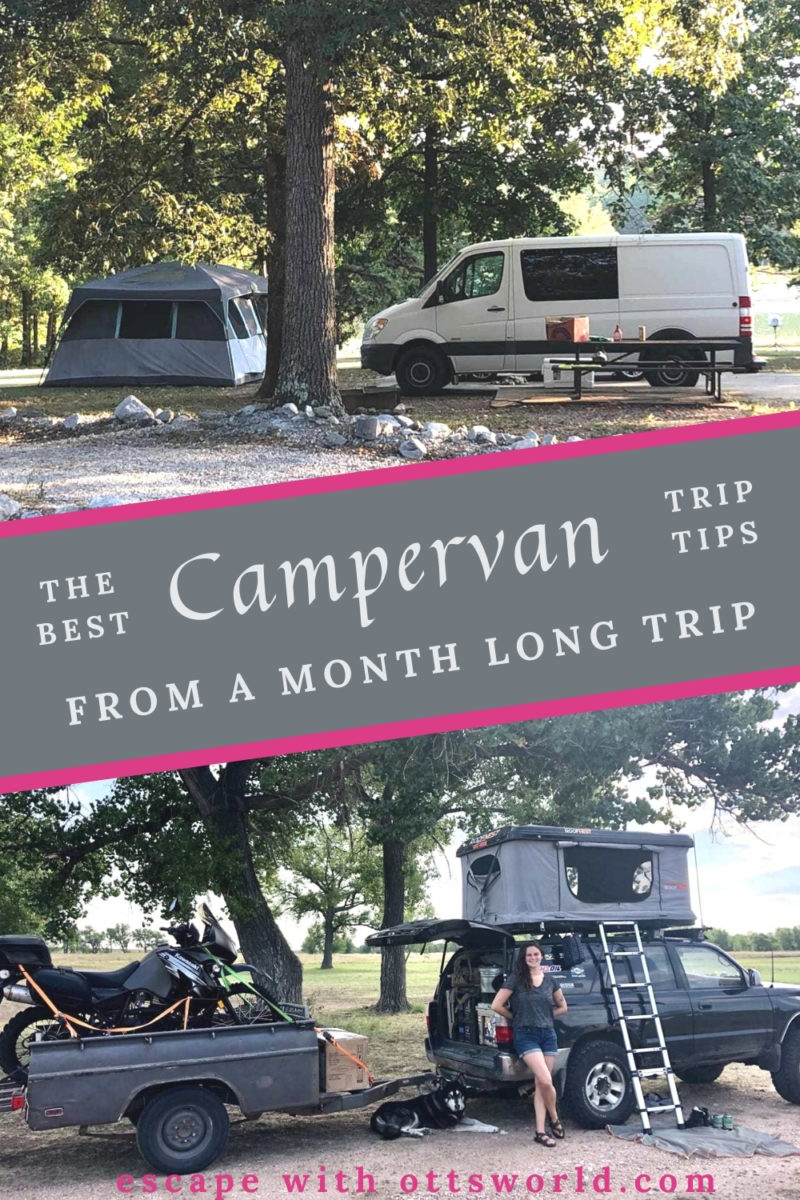
2. Decide What Kind of Places You Want to Explore
If you want to see a lot of cities, then going smaller is far easier to maneuver unless you haul a car so you can park your RV in the outskirts of town, and explore the city in your car.
I do wish, however, that Sophie had 4 wheel drive. In some of the national forests I’ve visited, I would love to go down some inviting gravel and rutted roads, but I don’t want to risk getting stuck, particularly since I rarely would have cell coverage and sometimes there would be no one around to help. If you want to be able to drive everywhere and on awful roads, you will need to get 4 wheel drive.
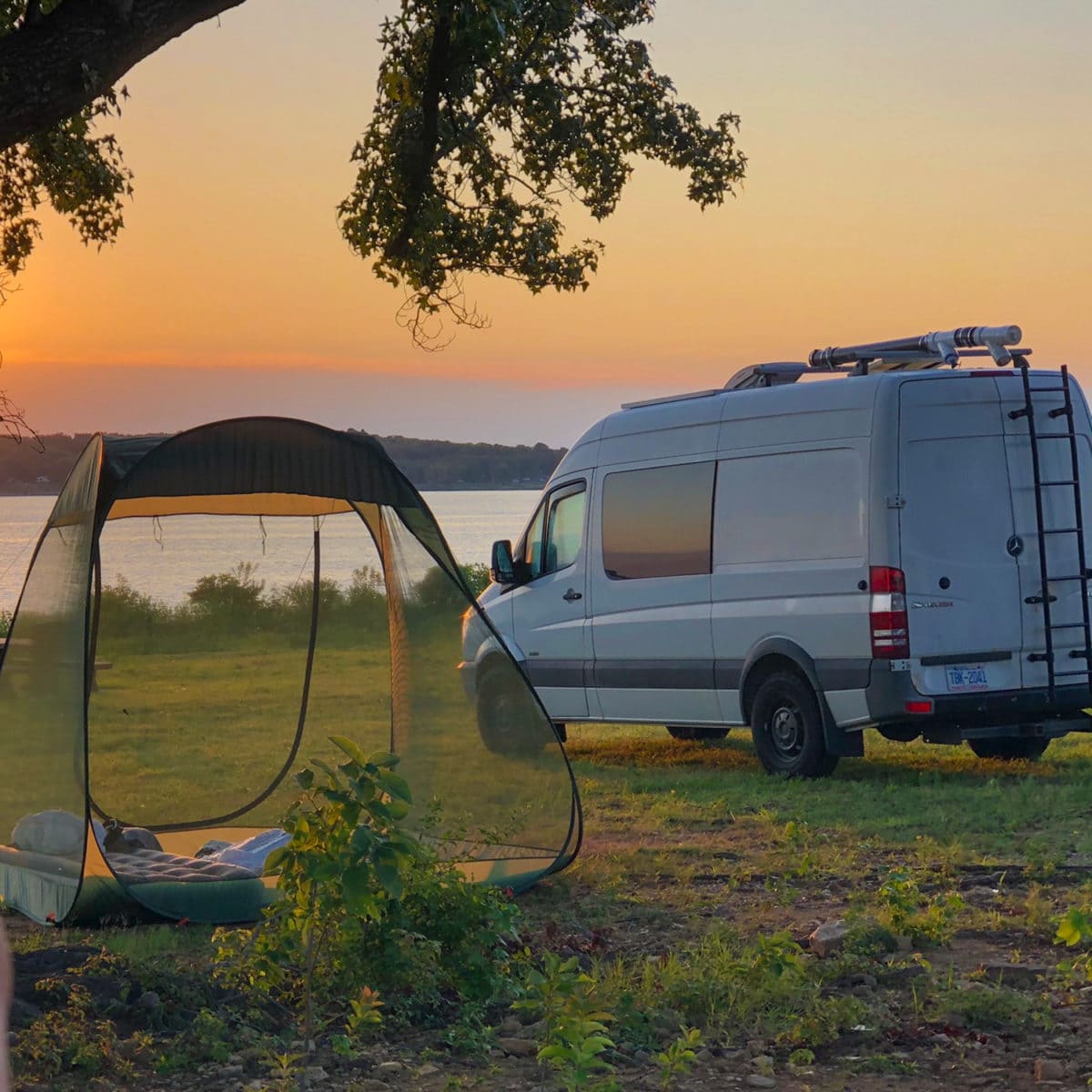
How Much Planning Should You Do on your Campervan Road Trip?
Some folks have to know what they are going to do every day and they actually enjoy the planning aspect of an adventure. I am not one of those people. My way has its pros and cons. It allows for serendipity and for changes when there is an important new fact, say bad weather is approaching – a definite pro. Conversely, not planning means I miss out when there are some cool things I would have liked to do, but unfortunately miss out on due to bad timing. This could be a museum or exhibit closing date, or missing a fun festival. Importantly, some places it is mandatory to make reservations in advance (especially during this pandemic), plus in some places, you won’t get a campsite unless you did book in advance.
For the most part, each morning I decide if I want to stay in the area longer, or wonder if I should pull out the atlas to figure out where to go next. For much of this trip, I have searched for state parks as I have been mainly on the East Coast and in the Mid-West where there are few national parks. I look for a place that looks promising and is less than a three hour drive, if possible. I try to stay at least two nights, so I’ve only been averaging around a hundred miles a day.
But regardless of your preferred style of planning, you should know what your sleeping options are when you take off in your camper van.
Read about Sherry’s Epic Colorado VanCation in her rented Campervan!
3. Campervan Parking: Where to stay in your Campervan
When you carry your home with you, you’ve got sleeping options. There are generally 3 options for parking and sleeping in your campervan. I love my Sophie-girl because she fits in a regular parking spot, which was a ‘must’ requirement for me. I didn’t want to worry about backing up a large RV, or hauling and backing up a trailer. Or even low clearances.
Stay at Campgrounds
This has been my preferred option as I like being able to take a proper shower after a day of adventure whenever possible.
I also usually splurge for a site with at least power, and often power and water, even though those sites are generally used by RVer’s with AC and their own private bathroom. I like the convenience, and on the hot nights, I have really appreciated my portable fan, since I don’t have a built-in camper AC. And even though it’s not much trouble, I like the convenience of refilling my water bottles, and cook pot with water from the spigot rather than tapping my 6 gallon storage jug.
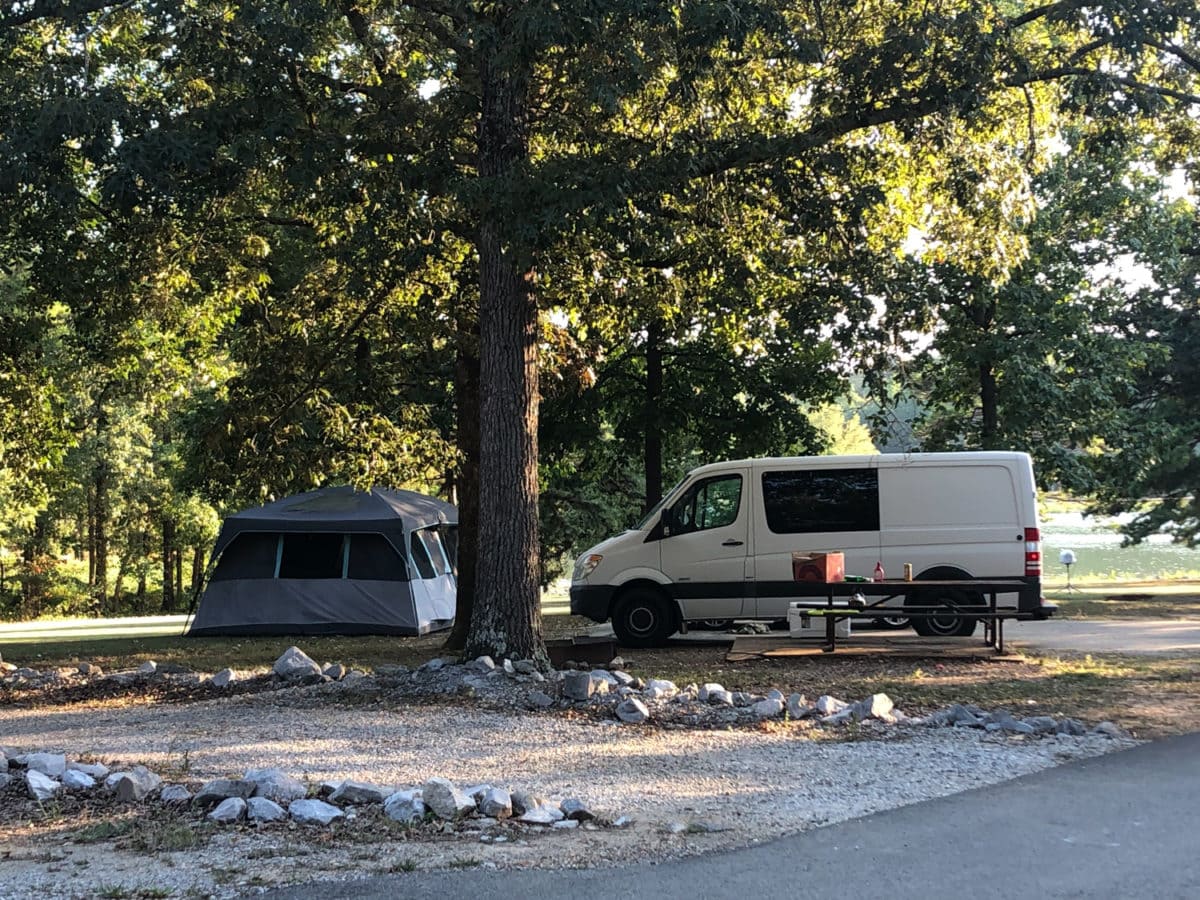
It usually costs 150% of a primitive site, but it is still economical at about $25/night on average during this summer of 2020.
Primitive campsites offer access to a bathhouse – sometimes it’s simply a compost toilet near these sites, and you walk over to the RV sites to use the bathhouse and get more water.
Primitive sites seem to run $10-$15/night. Campground may require you to set up a tent on a primitive site and not just sleep in your vehicle. I set up my screened porch and sleep in that when possible, so it hasn’t been an issue for me.
Campground Reservation and Extras
Campgrounds can be state or federally run, or can be private. I have used both, and prefer the former. Some even have amenities like golf courses, tennis courts and pools. Many have Disk Golf courses so bring your Frisbee! Check their websites.
Many government run campgrounds allow reservations, which for busy destinations, is a good idea, even if just a day or so in advance. They usually have a limited number of walk-in sites, and for busy locations, you want to get there first thing in the morning, or when they open up the sites (call first to find out, as sites may open up at check out, which could be 2pm).
Boondocking = FREE Camping
Boondocking is anywhere you camp for free!
The US government is the country’s largest landholder (so that means it’s OUR land, right?). On much of these federal lands, you can camp for free. They call it dispersed camping. As I write this from my beautiful boondocking site in the Bighorn National Forest of Wyoming, I have a great primitive campsite at absolutely no charge. I am allowed to stay here for 14 days before I am required to move on.
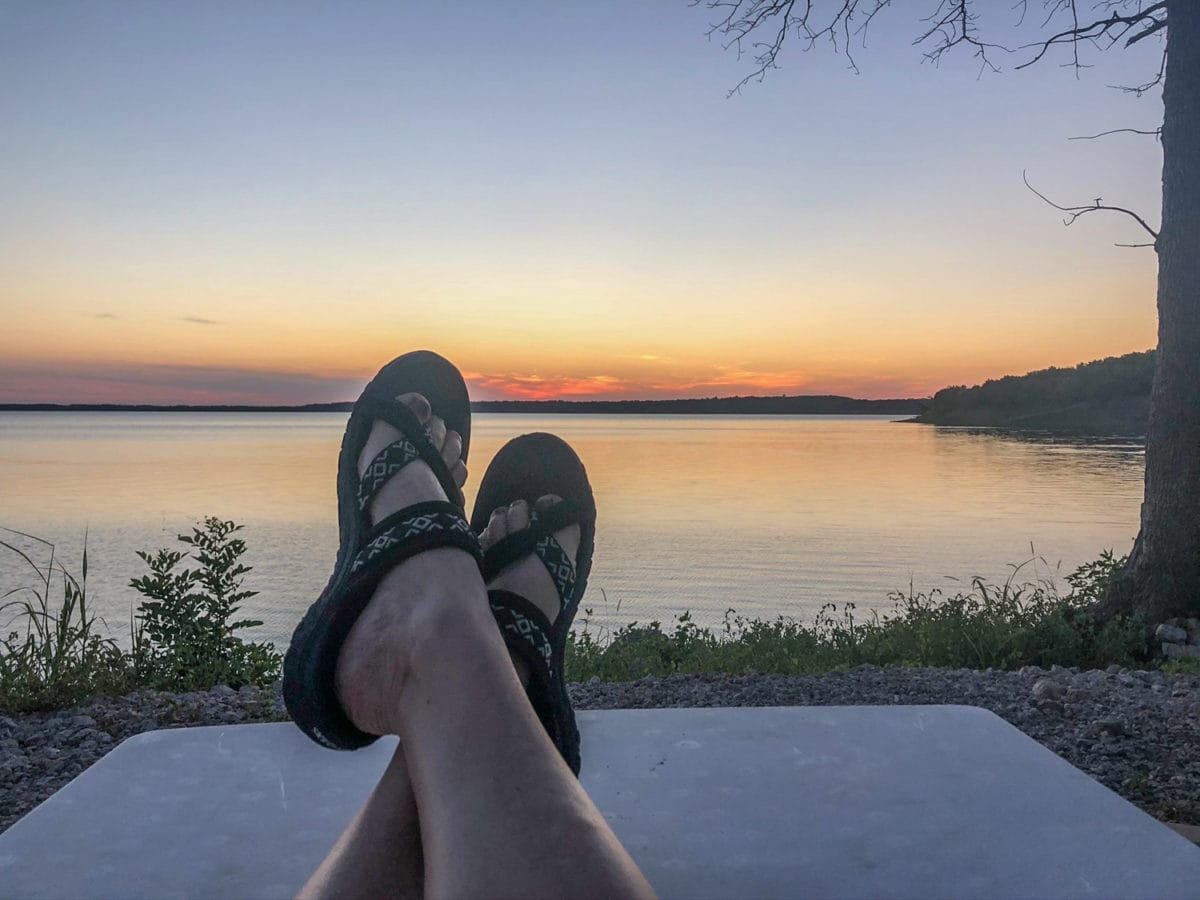
The rules here are, you must camp at least 300’ off the roads – where disbursed camping is allowed- and that seems to be virtually all offshoots of the main roads, of which there are dozens.
Boondocking opportunities can be found in many national forests and BLM land (Bureau of Land Management). Use this site to find boondocking opportunities on BLM land.
Park at Walmart, Sam’s Club and Cabella’s : Free Camping
This can be a great option when you are driving late and don’t really care about the environment, but want a safe place to stay and aren’t comfortable at a truck stop. Many of these chains allow overnight stays in your car, van or RV. You should call in advance to check with the store to be sure. It is nice to buy something from the store by way of thanks.
They do not allow you to bring out your camp chairs and tables; they just allow you to park there. You will generally see RVs congregating together, so it can be somewhat social. Of course, keep quiet, follow the rules, and pack up any mess so that they continue to offer this free option to travelers in the future. I understand you can stay a couple of nights.
Another free option that may be available, is to stay on a residential street, if there aren’t ordinances that forbid it. If you chose this route, and aren’t sure of the law, plan to get there after dark and leave in the morning to minimize chances of the police knocking on your window in the middle of the night. It helps if you don’t drive a rusted out beater that alarms the neighbors.
Truck stops can be another free alternative. They also offer (paid) showers.
Check out this supplemental list on what I actually USED during my first five weeks on the road in Sophie. It probably is less than a third of what I packed. Use it to help you pare down your supply list so you don’t overpack like I did!
Ready to Hit the Road in Your Campervan
So now you’ve analyzed what features you particularly need in a camper van, you know the types of places you want to explore, and you know what types of places you want to stay, so now you can decide what type of camper van is right for you: a big or medium sized RV, a regular camper van, a customized cargo van (like Sophie), or your car.
This is actually a wonderful time to get out an explore your home country in a camper – have fun!
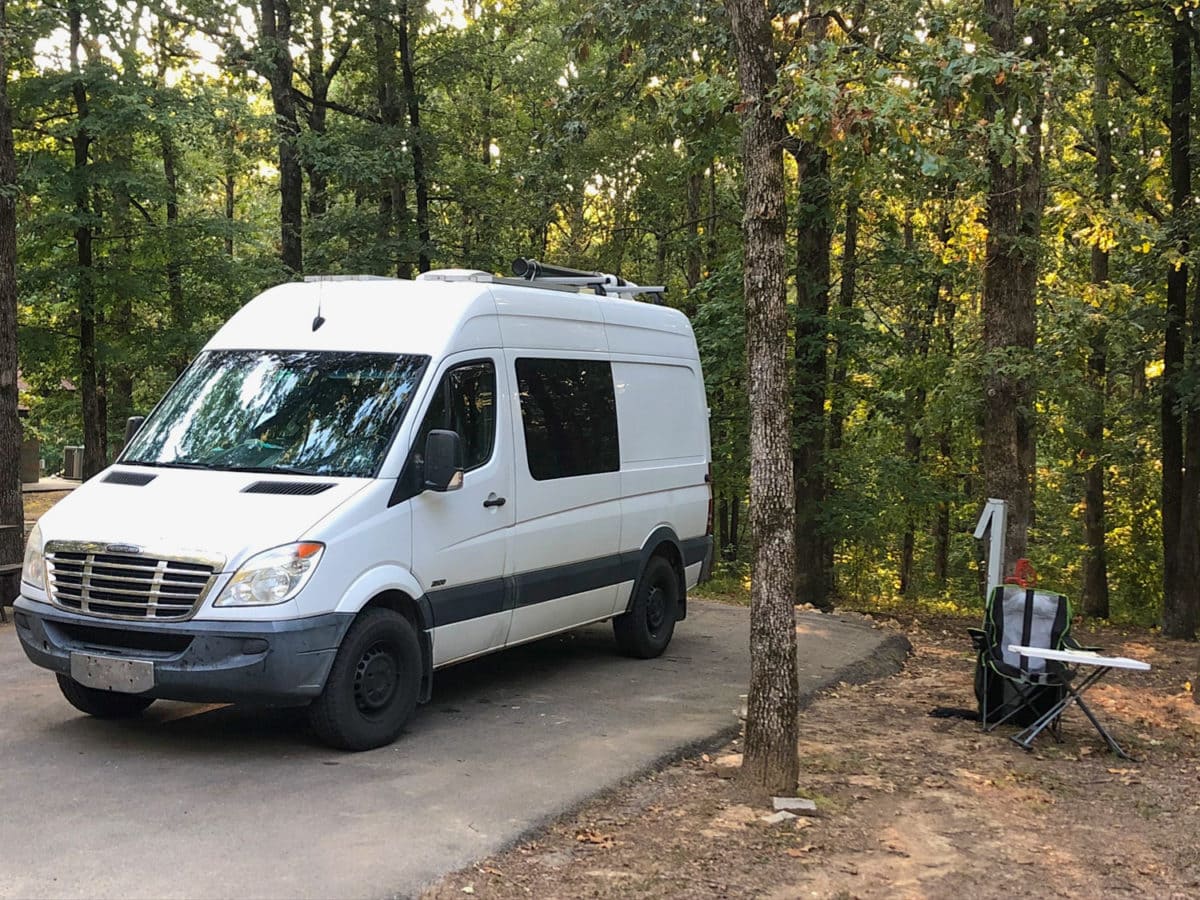
How you can learn more: When I return from my road trip in Sophie, I will be podcasting about it on my Active Travel Adventures show. You can subscribe now on your favorite podcast app so you don’t miss the episodes that go in to more detail about what life is like traveling the country in a camper van. You can also check out more photos and information on the website, once published.

Meet the Author: Kit got bit by the adventure travel bug in her early 50’s and now makes it her mission through her Active Travel Adventures (ATA) podcast and website to inspire and empower you to lead a bigger life through adventure travel. On ATA, Kit chats with folks who have gone on exciting adventures like walking the West Highland Way, or even our own Sherry Ott about walking Saint Olav Ways in Norway or the Kumano Kodo in Japan. On each show, we are hiking, biking, and/or paddling as we explore new cultures and destinations. Check out the podcast directory here. If you are new to adventure travel and want to beef up your skills, check out Kit’s companion podcast, the Adventure Travel Show Podcast, which teaches you the skills you need to build the confidence to go on a grand adventure.
Connect with Kit:
Subscribe to either podcast for free from any podcast app or you can subscribe to the Active Travel Adventures podcast here and the Adventure Travel Show podcast here.
ATA Facebook | ATA Facebook Group | Twitter | Instagram | Pinterest
What to Pack for Your Campervan Road Trip Based on Experience
In a month, here’s what I actually used out of all the stuff I packed. Note that I am traveling solo and I kept to a VERY basic diet, which I outline below as well, in case you want to use it as a baseline for your meal and kitchen supply planning. I haven’t been cooking except for boiling water for my tea and making hard boiled eggs for my salad (but I thought I would and packed WAY too much!)
Campervan Basics
• Dish soap
• Liquid hand soap
• Sanitizing gel
• (1) glass
• (1) medium sized refrigerator dish
• Small cutting board
• Small pot and lid
• (2) Plastic plates
• Stick lighter (for propane cooktop)
• (1) mug
• Thermos for my tea
• Sponge
• 16 oz Camp Stove propane gas and spare
• Small dustpan and hand broom
• Small cooler
• Dish towel
• Small dish cloth to wipe down counter
• Rags
• (1) steak knife
• (2) spoons
• (2) chip clips
• 25’ exterior extension cord (wish it were 50’)
• Small fan
• Full set of sheets for my van bed
• Twin set of sheets for my blow up mattress for the screen porch
• Two blankets
• Four pillows
• Bath towel
• A container with bar soap and a buffer (for bathhouses)
• Flip flops for camp bathhouse showers
• Two ‘bathhouse’ mesh bags: one carries my bathhouse toiletries and the other my clean, and then post-bath, dirty clothes
• A ‘demoted’ towel for wiping down things like the floor of a damp screen porch
• Battery operated lantern
• 50’ parachute rope for clothesline
• A large baggie with clothes pins (or a pinless clothesline)
• Laundry soap
• 5 gallon bucket (my emergency toilet)
• A 8 x 10 tarp and rope (I will bring a larger one to go over my screen porch next trip, as it doesn’t handle the rain)
• I haven’t used these, but would still bring my mini hardware kit for repairs, as well as a small kitchen fire extinguisher, and a small frying pan
• I use plastic grocery bags as my trash bags
• All my toys and accessories for backpacking, biking, hiking and kayaking
• Clothing and toiletries
• Pantry stock and staples
• Reading material and maps
• Laptop, phone and chargers
Example of Food to Bring
I don’t have a problem eating the same things over and over again. My refrigerator is the size of a regular chest cooler, so I don’t have a tremendous amount of storage either. Here’s what I eat virtually every day:
Breakfast:
½ apple
Vanilla yogurt
Hand full of walnuts on top
Often cantaloupe
Lunch:
Deli turkey breast
Whole wheat bread
Mayo
Tomatoes
Spinach
Grapes or a plum
Potato chips (my vacation indulgence)
Dark chocolate (mandatory indulgence)
Snack:
Cheese and crackers
Beer and/or wine
Dinner:
Rotisserie chicken
And/or a hard boiled egg
Chopped kale and cabbage salad mix
Cottage cheese as dressing (although it comes with some)
Toppings: sesame seeds, pumpkin seeds and oat bran sesame sticks
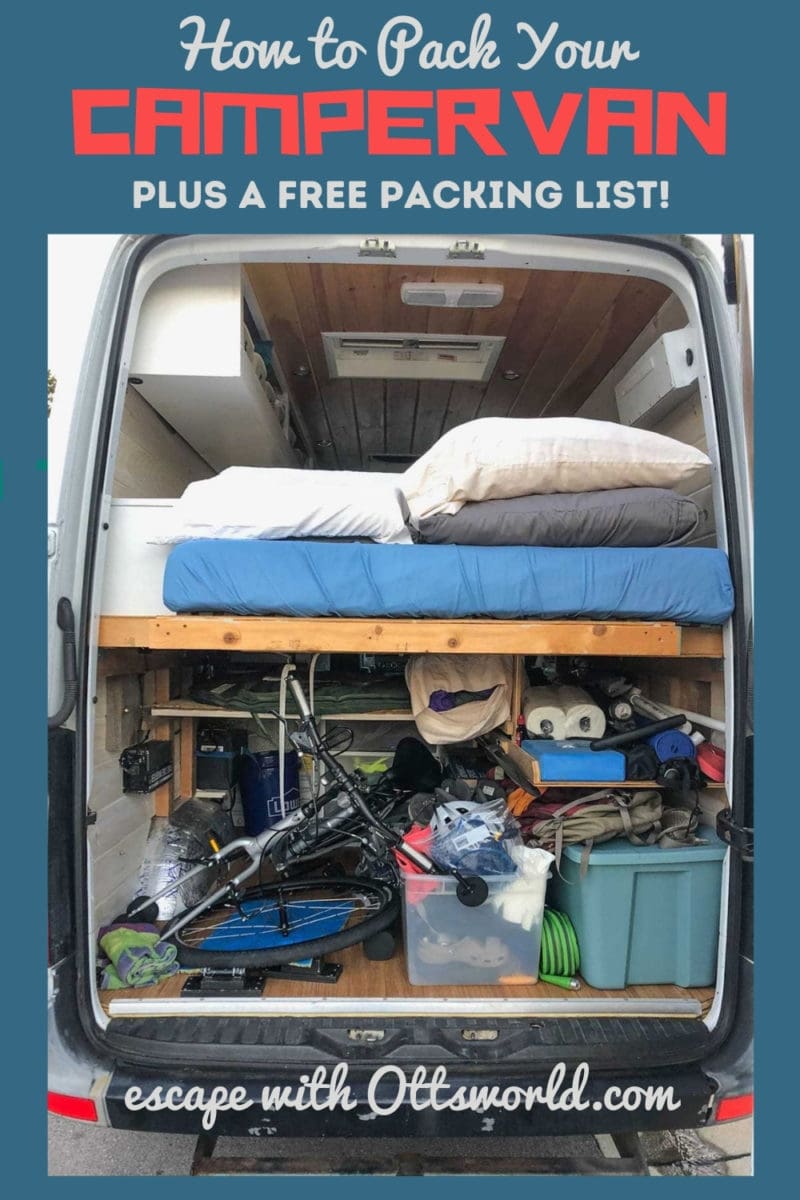


By Kit Parks September 25, 2020 - 8:54 am
I’m happy to answer any questions you might have about traveling around in a camper van – it’s a blast!